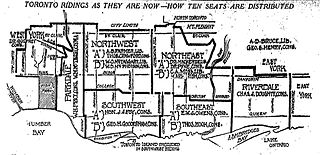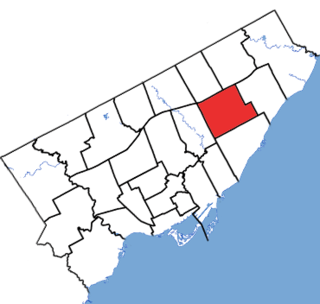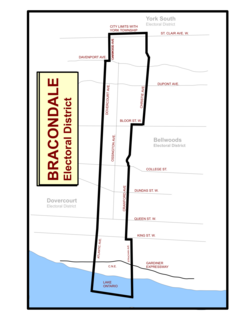
St. Andrew was a provincial electoral district in Ontario, Canada, that was established to elect Members of the Legislative Assembly (MLAs) and then Members of Provincial Parliament (MPPs) to the Legislative Assembly of Ontario.

Bellwoods was a provincial riding in Ontario, Canada in the old City of Toronto's west-end. It was represented in the Legislative Assembly of Ontario from 1926 until 1987, when it was abolished and redistributed into the Dovercourt, and Fort York districts.
St. Andrew—St. Patrick was a provincial electoral district in Ontario, Canada, that returned Members of Provincial Parliament (MPPs) to the Legislative Assembly of Ontario at Queen's Park.

Riverdale was a provincial riding in Ontario, Canada that existed from 1914 to 1999. It occupied an area east of the Don River from the city limits just north of Danforth Avenue south to Lake Ontario. It was named after the neighbourhood of Riverdale. In 1999 a major reduction in Ontario seats resulted in Riverdale being merged with part of East York into a larger riding called Broadview-Greenwood.

Dovercourt was the name of a provincial riding in Ontario, Canada. It existed from the 1926 election to the 1999 election. When it was established, it bordered Brockton on to the west, York South to the north, and Bracondale on the east. Lake Ontario was its southern border for most of its existence. At its abolition in 1999, it consisted of that part of the city of Toronto bounded on the north by the former city limits, on the east by Bathurst Street, on the south by Bloor Street and on the west by the CN Railway and St. Clair Avenue. It was redistributed into Davenport, St. Paul's and Trinity—Spadina ridings.

Eglinton was a provincial electoral district located in Toronto, Ontario. From 1926 until 1999 it elected members to the Legislative Assembly of Ontario. At its abolishment in 1999 it consisted of the neighbourhoods of Davisville and Lawrence Park in the north end of the old city of Toronto. It was abolished into Eglinton—Lawrence, Don Valley West and St. Paul's.
Beaches—Woodbine was a provincial electoral district in Ontario, Canada. It was created in 1967 by merging the former ridings of Woodbine and Beaches.

York Centre is a provincial electoral district in Ontario, Canada, that has been the name of ridings in the Legislative Assembly of Ontario three different times. It was created initially in 1955 from the southern part of York North. It was dissolved in 1963 when it was split into three ridings called Yorkview, Downsview and Armourdale. In 1967, it was reconstituted north of Steeles in the township of Markham. This lasted until 1999 when it was dissolved into Markham—Unionville. The name was given to a new riding formed in its original location south of Steeles. It remains as an existing riding today.
Fort York was a provincial electoral district in Toronto, Ontario, Canada. It was created in 1987 and was subsequently abolished in 1999 when the ridings were redistributed to match their federal counterparts. The riding had only two representatives:

St. George was a provincial riding in Ontario, Canada, that returned Members of Provincial Parliament (MPPs) to the Legislative Assembly of Ontario at Queen's Park. It was created in downtown Toronto in 1926 and was merged into the riding of St. George—St. David in 1987. The seat covered much of the city's central core, roughly similar to the current riding of Toronto Centre. At its dissolution it stretched from University Avenue to Parliament Street and from the waterfront north past St. Clair.

St. Patrick was a provincial electoral district in Ontario, Canada, that was established in 1926 out of the district of Toronto Northeast. It lasted until 1967 when it was merged with St. Andrew to form St. Andrew—St. Patrick.

Woodbine was an Ontario provincial electoral district that existed from 1926 to 1967. It covered a section of the eastern city of Toronto east of Jones Avenue and west of Woodbine Avenue. In 1966 there was a major redrawing of the riding boundaries in Toronto and the riding was split. The portion east of Greenwood Avenue was merged into the Beaches—Woodbine and the portion west went into the Riverdale riding.
Yorkview was an Ontario provincial electoral district (riding), in the former city of North York from 1963 to 1999. The riding was established for the 1963 Ontario general election. The riding was abolished in preparation for the 1999 Ontario general election. It was partitioned into the current provincial ridings of York West, York Centre and York South—Weston.

Scarborough Centre is a provincial electoral district in Ontario, Canada, that has been represented in Legislative Assembly of Ontario since 1963.

Bracondale was a provincial electoral district in Toronto, Ontario, Canada. It was represented in the Legislative Assembly of Ontario from 1926 to 1967. The constituency got its name from an old Toronto suburb called Bracondale, that was annexed by Toronto in 1909. Its most notable event was electing one of the first two women Members of the Provincial Parliament (MPP) to share the title "first-woman MPP" in 1943 when Rae Luckock was elected. In 1965, Bracondale's MPP, Joseph Gould, died in office sparking the final election held in the constituency. George Ben won the by-election, and became the constituency's last MPP. It was abolished for the 1967 Ontario provincial election, and redistributed into the Dovercourt and Bellwoods constituencies. As of 2012, the current electoral districts of Davenport, St. Paul's and Trinity–Spadina encompass this historic riding.

Parkdale was a provincial riding electing Members of Provincial Parliament (MPP) to the Legislative Assembly of Ontario. The riding was created from the western part of Toronto West riding in 1914 and abolished in 1996 and redistributed into the Parkdale—High Park, Davenport and Trinity—Spadina ridings for the 1999 Ontario general election.

Beaches was a provincial riding in Toronto, Ontario represented in the Legislative Assembly of Ontario from 1926 to 1967. It was carved completely out of the existing riding of York East. Its boundaries remained the same until 1967 when it was merged with the neighbouring riding of Woodbine to become Beaches—Woodbine. Other than a single session in the 1940s, the riding was steadfastly Conservative in its voting preference.
Armourdale was a provincial riding in Ontario, Canada. It was represented in the Legislative Assembly of Ontario from the 1963 provincial election until it was eliminated in 1987, when most of its territory was incorporated into the ridings of Wilson Heights, Willowdale, and York Mills. Armourdale was created from part of the former riding of York Centre. It was in the former borough of North York and occupied an area to the west of Yonge Street and east of Bathurst Street.
Scarborough West was a provincial electoral district in Ontario, Canada. It was created prior to the 1963 provincial election and eliminated in 1996, when its territory was incorporated into the riding of Scarborough Southwest. Scarborough West riding was created from part of the former riding of York—Scarborough. It was in the former borough of Scarborough.
Scarborough East was a provincial electoral riding in Ontario, Canada. It was created prior to the 1963 provincial election and eliminated in 1996, when most of its territory was incorporated into the riding of Pickering—Scarborough East. Scarborough East riding was created from part of the former riding of York—Scarborough. It was in the former borough of Scarborough.






